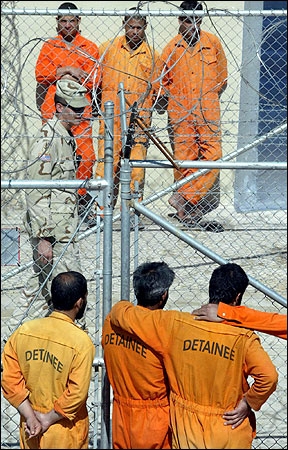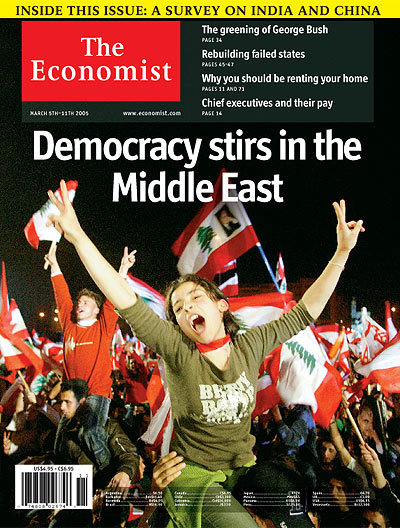Notes
Missing the Subject

According to the New York Times, this shot — on Friday’s front page — is missing the subject.
The accompanying article (American Jails in Iraq Are Bursting With Detainees — link) deals with the number of people being held in Iraq as American captives. The caption, though, is what I wanted to focus on. I don’t know if it’s a disclaimer, an apology, or a tease, but it reads:
An American M.P. stood guard as detainees watched a comrade, not shown in photo, receive medical treatment at a base in Tikrit.
How often do you see a photo on the cover of a major newspaper (it’s on the website too) identified by what isn’t shown? I don’t know if the paper intended it, but it has a curious consequence. The result is to emphasize how much is going on just outside public view.
Having us assume that a prisoner is receiving medical attention, I belief, is asking for a leap of faith. By providing a conclusion without evidence, you’re just tempting people to consider alternative explanations. And, with the credibility the press has these days (especially in keeping the government honest), who is so willing to accept explanations sight unseen?
So, I invite you to try something. Slowly scan the picture from left to right. Then, in your mind’s eye, continue tracking to the right until you come upon the supposed comrade getting the medical treatment. Now, what do you see?
If this sounds like a silly exercise, I think it’s not nearly as dumb as the little hole the Times editors opened here. I say this because this weird omission they set up represents not just a visual mystery, but an editorial problem. Of course, once you inform the reader an invisible person is getting medical treatment, you are guaranteed folks will want to know just a few more things, such as who, how and why.
(By the way, You didn’t visualize anything besides a prisoner receiving medical attention, did you?)
Because the Times opens up the door to free association, I was wondering if this photo might actually have some connection to the paper’s lead story on Sunday. (Rule Change Lets C.I.A. Freely Send Suspects Abroad to Jails — link. ) In that article, it is disclosed that the Bush administration has given the C.I.A. broad authority to ship terror suspects to other countries for detention and interrogation. The process, known as “rendition,” is the sort of outsourcing I don’t think the government is interested in having closely examined. And who are the “prime subcontractors” in this network? According to the article, the merry band includes the burgeoning democracies of Egypt, Syria, Saudi Arabia, Jordan and Pakistan.
(Sort of makes you wonder whether Guantanamo is an import or an export.)
Of course, the article has all the expectable denials when the “t” word comes up. However, there are some interesting quotations regarding the possible use of torture. For example, there is this passage based on Porter Goss’ confirmation hearing last month.
“We have a responsibility of trying to ensure that they are properly treated, and we try and do the best we can to guarantee that,” Mr. Goss said of the prisoners that the United States had transferred to the custody of other countries. “But of course once they’re out of our control, there’s only so much we can do….”
Also, an unnamed official said: “We get assurances, we check on those assurances, and we double-check on these assurances to make sure that people are being handled properly in respect to human rights.” (B)ut, nothing is 100 percent….”
Of course, this image can serve as the departure point for any number of barely visible stories these days. To cite one more, there was also a report this weekend about a prisoner abuse video shot by National Guard soldiers in Ramadi. (Video Showed Iraqi Prisoners Being Kicked By Soldiers – link). The incident surfaced after a threatened ACLU suit forced the Army to release an additional 1,200 pages of documents related to questionable detainee treatment in Iraq. In one case, a video was made showing an Iraqi prisoner being kicked by soldiers in a unit from Florida. The prisoner was believed to have died shortly after the beating.
And, while we have the photo in front of us, there might be a few other things worth taking up.
For instance, what’s with that hand coming into the shot from the lower right? It almost makes you think the guy with the hand on his hip is about to be removed. Seriously though, why do these guys have their arms around each other (especially when the other prisoners look so autonomous)? Is it incidental? Are they just friends? Or, could it be a specific emotional reaction to the scene we can’t see?
Maybe some answers are suggested in the prisoner arrangement. Since the guys inside the fence seem so aloof, while the guys outside seem so engaged in what’s going on, is it possible that the comrade belongs to the outside group? Also, if there is a difference between the inside and outside group, what are the possible explanations? Could it be ethnic? Religious? Geographic? (I didn’t notice it before, but the three guys on the outside all have beards, while the guys inside are clean shaven.)
I’m glad the Times left this hook in their caption. It reminds me how controlled the focus is when it comes to Iraq, and how often we get a short-sided picture.
(image: Shawn Baldwin for The New York Times)


Reactions
Comments Powered by Disqus